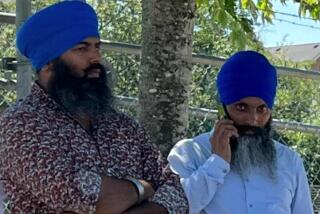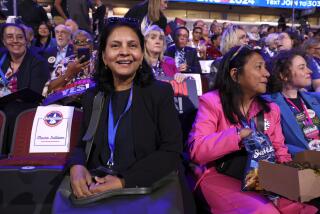Sikhs Celebrate Major Anniversary
- Share via
The hymns were played, the scriptures read and the prayers recited, but members of the Nanak Sadan Sikh Temple in Northridge still had another key religious practice to perform at their gathering this week: They sat down on the floor together to share a free community meal of chapati bread and Indian-spiced lentils and potatoes.
For Sikhs, who celebrate a key religious anniversary this month, the meal prepared in the langar, or community kitchen, represents far more than food. As central to Sikh tradition as turbans and ceremonial daggers, the langar is the symbol of equality, one of the key beliefs of the 20 million Sikhs who make up the world’s fifth-largest religion.
Sikhism was developed about 500 years ago as an answer to the social ills prevalent in the majority Hindu and Islamic societies of what is today Pakistan and the northern Indian state of Punjab. Relatively free of dogmatic theology and compulsory rituals, Sikhs profess faith in one God, universal love, honest work and truthful living.
“This is not a charity meal. It is a meal where rich man and poor man, people from every caste, men, women and children all come together, sit down and eat,” said Jasprit Singh, a visiting professor of engineering in Santa Barbara. “The message the langar gives is equality.”
But as Sikhs this month celebrate the 300th anniversary of the Khalsa Panth--the religion’s formalized practices and beliefs--the langar tradition has become the focal point of a sometimes explosive controversy between North American temples and central authorities in Punjab.
In a struggle over local adaptation of religious tradition, central Sikh authorities have banned the growing Western practice of using tables and chairs during community meals in the temples. In decreeing that use of furniture violates the letter of the langar tradition, Punjab authorities sought to quell the occasionally violent power struggles over the issue between fundamentalists and moderates.
The controversy has raged most strongly in the older and more established Sikh communities of Canada, where the issue has sparked near-riots in a few temples.
In the United States, home to about 250,000 Sikhs, about 90% of temples have removed tables and chairs in peaceful decisions to conform with the central ruling, said Hakam Singh, a Monrovia community leader and retired chemistry professor. The other 10% give worshipers the option of using tables and chairs.
*
“The [langar] tradition helps us cultivate equality and humility, but it doesn’t threaten the religion if we sit on chairs,” said Gajinder S. Singh, a leader of the Sikh temple in Northridge and an insurance executive. “[Punjab] should not dictate to us.”
Temple members here view the issue as a largely irrelevant political power struggle cloaked in religion, and are far more eager to discuss other aspects of their faith. Every weekend for the last year, they have held 48-hour nonstop readings of the 1,430-page holy book, known as the Guru Granth Sahib, in a run-up to the Khalsa Panth’s 300th anniversary Wednesday.
Last Sunday, more than 10,000 Sikhs celebrated the anniversary in a colorful procession of floats through downtown Los Angeles.
The Khalsa Panth, created by the religion’s 10th and final guru, Gobind Singh, in 1699, gave the religion its formalized and unique code of conduct. That includes the “five Ks” of Sikhism: the kesh, or uncut hair, symbolizing acceptance of God’s creative beauty; the kangha, or comb, reminding Sikhs of their stewardship duties; the karha, or steel bangle, representing the unbroken connection among mind, body and soul; the kirpan, or dagger, symbolizing the fight against injustice; and the kachha, or undergarments, which embody the Sikh belief in physical activity, sexual fidelity and social volunteerism.
The guru also gave all Sikhs the name Singh--which means lion--as a declaration of the equality of humankind amid the oppressive caste system of India. Although Sikhs retain vestiges of caste differences today that still determine, for instance, marriage partners, community members say they are not used as a measure of a person’s inherent worth.
Indeed, the religion’s ideal of equality is a major point stressed by Sikhs--including women.
“I can speak freely. I can sit with men. I can perform religious services. I am fully respected,” said Waryam K. Singh, the Northridge temple’s assistant treasurer.
The religion’s founder, Guru Nanak, called women the “originator of civilization,” while the second Guru Amar Das fought against the Muslim veil and the Hindu custom of forcing wives to burn themselves atop their husband’s funeral pyre. The Sikh morning prayer declares: “We are born of women, we bow before women, we marry women, we are friends with women . . . so why consider women inferior?”
*
Women still face barriers--no woman has ever been named one of Punjab’s five head priests, for instance--but Sikhs say those roadblocks are being steadily removed. In a historical breakthrough, the ruling Sikh body in Punjab appointed a woman, Jagir Kaur, as Sikhism’s top religious official last month--the first time a woman has held such a post.
Despite attractive elements, however, Sikhism retains a low profile in the United States and, members of the faith say, suffers from widespread public ignorance.
Largely because of their turbans, Sikhs say that they are often mistaken for Arabs by adults--and for genies and snake charmers by children.
Other Sikhs say they have been denied service at restaurants or rejected for jobs because of their turbans.
But governed by the creed of “Chardhi Kala,” or boundless optimism, few Sikhs seem to dwell on such problems.
Like other Sikhs, Jasprit Singh takes active steps to educate Americans about his faith. When his son transferred to a Santa Barbara school, Singh gave a class demonstration on how to tie and untie a turban, and unwind, comb and retie the hair.
“The kids were so excited, they wouldn’t let me go home,” said Jasprit Singh.
“The most important thing is to bring the religion of Sikhs into the proper public light,” he said. “We want to portray ourselves as part of Americana.”
One reason for widespread public ignorance about Sikhs, experts say, is the community’s relatively short history here. The first Sikh temple was established in Stockton in the early 1900s, and California still houses more than a third of American Sikhs. The majority came only after immigration laws were liberalized in 1965. As a result, experts say, the vast majority of Sikh temples still perform services in the Punjabi language, making outreach to Americans difficult.
Mukta Kaur Khalsa, a former Angeleno who now lives in New Mexico, is a follower of Yogi Bhajan, a Sikh guru who came to Los Angeles in 1969 and attracted a large American following through teachings of kundalini yoga and meditation. Every day, she rises about 4 a.m., takes a cold shower and performs her 2 1/2-hour morning worship. Like other members of the Bhajan’s group, the Sikh Dharma Brotherhood, she has a turban covering her uncut hair and wears all-white clothing, to keep, she says, the consciousness of stability and purity. Khalsa also runs an addiction treatment service using yoga, meditation and a vegetarian diet.
“As a Westerner, [the practices] are very foreign. People tend to think it’s just a fad,” she said. “But over the years, they’ve seen it’s not a fad and how at peace and happy I am with myself.”
Bhajan is regarded with suspicion by some Sikhs who reject what they view as a cult of personality and yoga practices that are Hindu, not Sikh. But the guru has 120 yoga centers around the world, including one temple in Los Angeles.
The other eight Sikh temples spread across Southern California cater mainly to Punjabi immigrants, with two more scheduled to open soon in Canoga Park and Pomona.
Sikh leaders say that more temples are moving toward English to meet the needs of their American-born offspring. In July, the younger generation plans to hold a Sikh Renaissance Conference in the Los Angeles area to address such questions as how to make the religion more responsive to their needs and how to retain a Sikh identity amid the powerful forces of acculturation.
“We are trying to slowly bring in acculturation both to the orthodox and the young people,” Hakam Singh said. “For the sake of our community, this change has to come and will come.”
More to Read
Sign up for Essential California
The most important California stories and recommendations in your inbox every morning.
You may occasionally receive promotional content from the Los Angeles Times.














